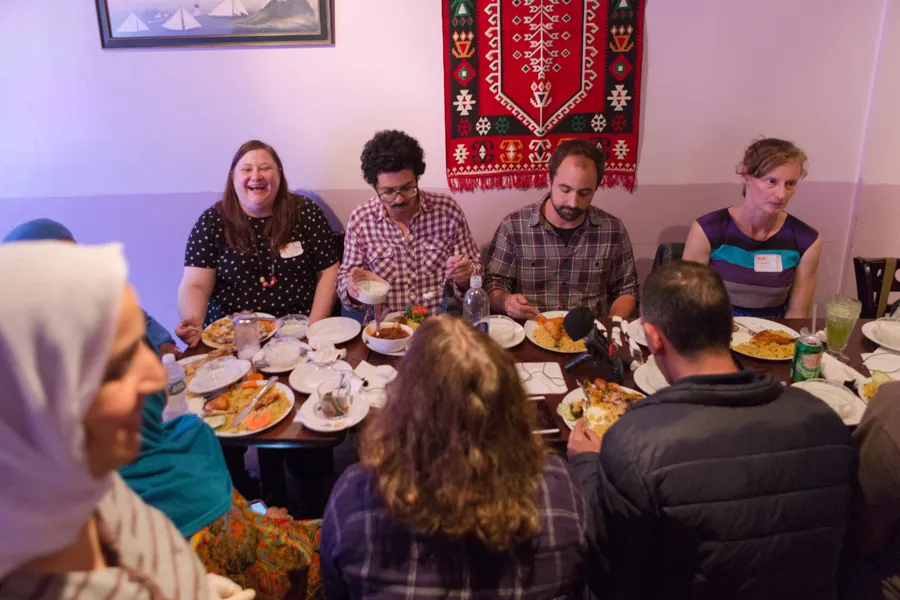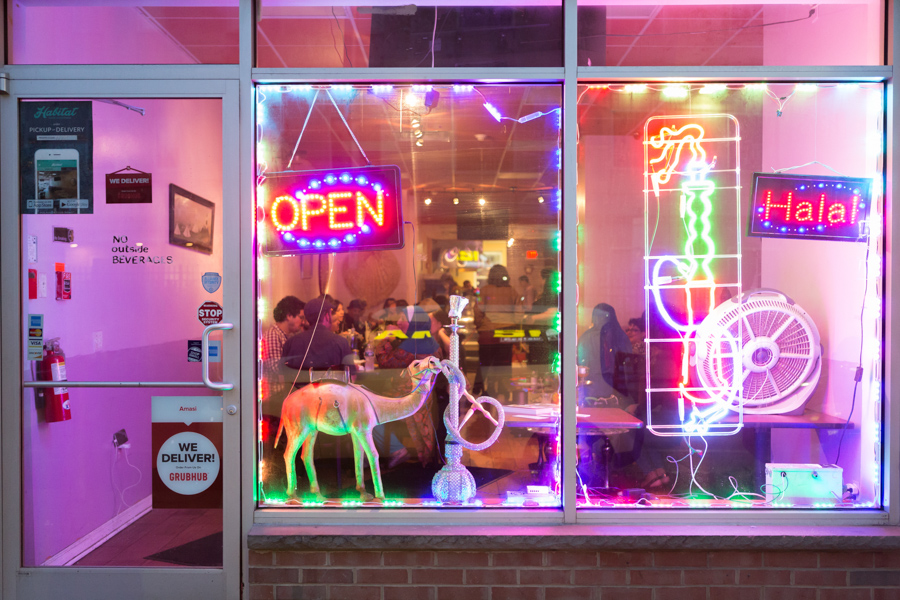“The America I Want to Live In”: Curator Elizabeth Thomas on Radio Silence

We’re counting down to the launch of Radio Silence on July 30 with curator Elizabeth Thomas, who’s worked with artist Michael Rakowitz on this project for more than three years. Part performance, part radio show, Radio Silence takes on the unspoken experience of the Iraqi diaspora, creating a soundscape woven from refugee and veteran stories that will unfold over the public airwaves this fall.
Could you talk a little bit about how this project has evolved since its conception?
We invited Michael Rakowitz to Philadelphia knowing of his ongoing work with Iraq War veterans and Iraqi refugees—collaborators that mirror the kinds of community participants at the core of the Mural Arts mission, and match its history of making public art. We knew from the beginning that Michael wouldn’t make work in the form of a mural, but other than that we left the possibilities completely open.
Over the years, Michael has:
- re-opened his grandfather’s Iraqi date import/export business in a Brooklyn storefront,
- remade artifacts stolen from the Iraqi National Museum out of Middle Eastern food packaging,
- opened the first Iraqi–Jewish restaurant in the Arab world,
- served dinner to New Yorkers on Saddam Hussein’s own china,
- and staged an homage to the Beatles’ farewell concert on a roof in Jerusalem,
so when he decided that he wanted to bring Bahjat Abdulwahed—the man dubbed by a reporter as the “Walter Cronkite of Iraq”—back to the airwaves in Philadelphia after decades of absence, it was a completely expected surprise.
We knew then that we’d use the general structure of a radio program as some kind of variety–news–documentary hybrid. But over the many years we have worked with the Iraqis and veterans, the form and content of the project has been shaped by their contributions. Even this spring, when I thought we were done finding new elements for the project, we discovered a team playing under the Iraqi flag for Philadelphia’s Unity Cup, a local World Cup-style soccer tournament for dozens of teams of immigrant players.
What is it like, as a curator, to work with radio as an artistic medium?
For me, and for any curator with a desire to connect to the public, there is something incredibly seductive about working within media that have their own channels of public distribution—over the past 50 years in particular, artists have experimented with TV, radio, advertising, and the internet to find new pathways to reach the public with their ideas. Within that, I think there’s perhaps a utopian desire: to bring the subtleties and complexities of art directly into the patterns of daily lives, and in so doing, connect more than a museum can, in terms of reach, and more than the commercial world of media, in terms of poetic impact.
The most unusual thing about this project maybe isn’t so much that it uses radio, which may seem like a strange place to put art, but that it’s about who gets to speak, and how what they might share gets framed. Most of the time, real people who are sharing their experiences of war or their journeys from their homelands would only be presented in the context of documentary. But in the context of Radio Silence, each individual’s contribution is woven into the larger fabric created by Michael—a kind of fabulist structure that reconstructs the feeling of Iraq before the war, that suspends or conflates the time and space of now and then, the experienced and the imagined, and what might seem to be fiction or fable, but is totally real.

Who do you see as the ideal audience for Radio Silence?
All of us working on the project imagine different audiences for Radio Silence. The Iraqis we work with want all Iraqis everywhere to be able to hear it—those still in Iraq, or those who have left for Jordan, or Germany, or Indonesia, or California. The veterans too think of their colleagues in the military, or who have left the service. We all think of the Philadelphians we want to hear it, so they might know the people who share this city with them, but that they might never see otherwise. That goes for all of America, really. And we think of those who are interested in performance, and visual art, and in the use of radio and podcasting for telling stories in unique and creative ways; people who listen to Radiolab or This American Life or any number of podcasts.
What has been your favorite moment or experience in the Radio Silence process thus far?
This project has gone on for much longer than any other I have ever worked on. For various reasons, we’ve been in conversation with our collaborators for three years now, and the process has involved a lot of eating and talking and spending time together. The greatest luxury of the project is that we’ve had the time to allow these conversations to develop over years of dinners and gatherings in people’s living rooms, and individual meetings over coffee, where people have trusted us to share intimate, emotional realities of their lives, and corny jokes, and music, and so much tea with cardamom. I’m not kidding about the dinners—one day we had four dinners!

What are you most looking forward to when it comes to the live event on July 29?
The live performance is for me almost the opposite of the radio program—instead of the intimacy of being spoken to directly in your ear, the live performance is about presence and visibility.
In this cultural moment in particular, I am looking forward to seeing this little portal to Iraq open up on Independence Mall on July 30—music, food, people, stories, and all of this shared by Americans and soon-to-be Americans together. Our backdrop is based on a painting of Iraqi monuments, and the stage itself on the famous Ziggurat of Ur. The artist Mayyadah Alhumssi worked with Michael to design these elements in visual conversation with Independence Hall, which will be in the background. This melding of American and Iraqi monuments, this visibility of Iraqis and their culture, steps from the Liberty Bell, this to me feels like the America I want to live in.
Major support for Radio Silence has been provided by The Pew Center for Arts & Heritage, with additional support from The National Endowment for the Arts, and the Hummingbird Foundation. Project collaborators and partners include a host of agencies and nonprofits that work on refugee and veteran issues, as well as independent community-driven media nonprofits.